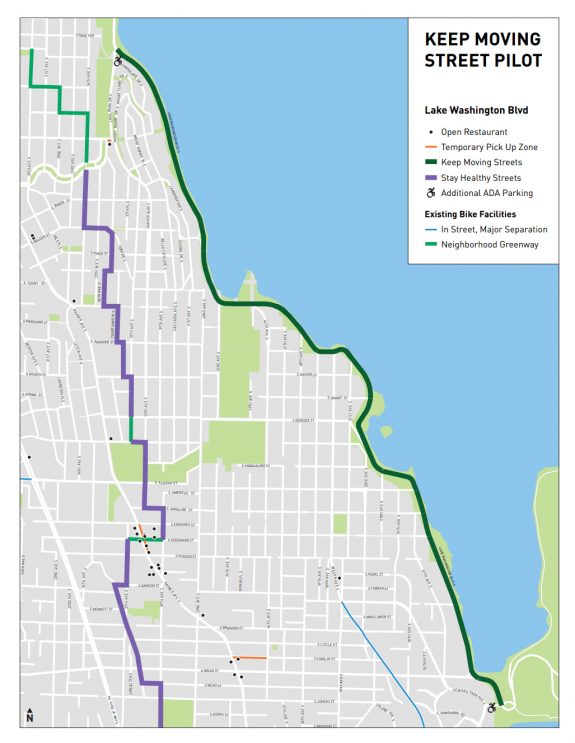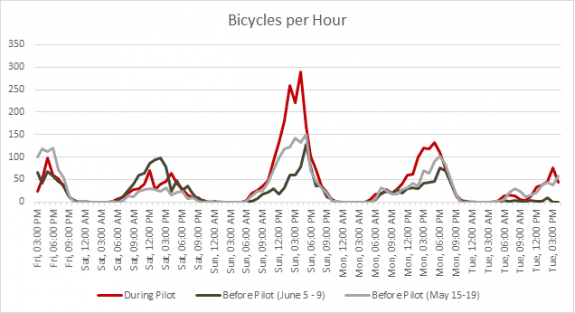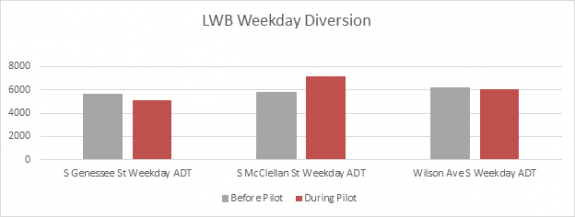 Lake Washington Boulevard is going car-free(ish) again starting Friday and continuing until at least Labor Day.
Lake Washington Boulevard is going car-free(ish) again starting Friday and continuing until at least Labor Day.
SDOT and Seattle Parks tested the concept of what they call a “Keep Moving Street” on the stories lakefront street for five days in late June. The street is marked as closed to cars, though people can still drive on it if they are accessing a home (whether they live there, are visiting someone or are making a delivery or service call). So it’s not entirely closed to cars, but cars are very limited. People are allowed to walk in the street, which helps limit overcrowding on the skinny sidewalks and paths along the lake.
The city collected feedback following the five-day test, and the response was very positive, according to an SDOT Blog post. More than two-thirds of respondents enjoyed the pilot, according to a non-scientific online survey.
Parking lots along the waterfront remain closed in an attempt by Seattle Parks to limit crowding in what would typically be one of the busiest summertime waterfronts in the city. This is where Seafair festivities are centered, after all. So closing the street helps to maintain that goal while also creating more open space for the people who do go there. Extra accessible parking has been added at both ends of the route, and the Seward Park parking lot is entirely dedicated to accessible parking.
How did the pilot go?
City staff studied travel habits and measured car and bike volumes before and after the June pilot, and it was successful by nearly every measure. Biking increased a lot, but not so much that overcrowding would become a problem, they found:
 Meanwhile, driving was way down, suggesting that the vast majority of people were obeying the signs. “Vehicle volumes typically range from 53 to 440 per hour and dropped to zero to 10 per hour,” SDOT notes in their blog post.
Meanwhile, driving was way down, suggesting that the vast majority of people were obeying the signs. “Vehicle volumes typically range from 53 to 440 per hour and dropped to zero to 10 per hour,” SDOT notes in their blog post.
The city also measure traffic levels on nearby streets to see if closing Lake Washington Boulevard would increase traffic on other streets. S Genesee St and Wilson Ave S both experienced decreases in traffic during the pilot. S McClellan St did experience an increase in weekday traffic compared to before the pilot, but traffic levels there were still far below the pre-outbreak levels. Weekend traffic on S McClellan St were down during the pilot.

 Though it may not at first make sense that nearby traffic would drop when closing Lake Washington Boulevard, this is likely for a couple reasons. Many of the those car trips on nearby streets would typically head to Lake Washington Boulevard. So with the street closed, those trips disappeared, too. And, of course, many people who would have driven to the waterfront instead took advantage of the Keep Moving Street pilot and walked or biked there instead.
Though it may not at first make sense that nearby traffic would drop when closing Lake Washington Boulevard, this is likely for a couple reasons. Many of the those car trips on nearby streets would typically head to Lake Washington Boulevard. So with the street closed, those trips disappeared, too. And, of course, many people who would have driven to the waterfront instead took advantage of the Keep Moving Street pilot and walked or biked there instead.
The city did not have a quality method for counting pedestrian volumes. They did set up a counter to count people crossing Lake Washington Boulevard at one point near Genesee Park and noted a decrease during the pilot. But this is very likely because people simply walked in the street or crossed at a different point since there’s no need to seek out a designated crosswalk when the street is closed. That’s one of the many benefits from projects like this. Anecdotal evidence suggests that walking in the street was quite popular.
"It feels safe to walk here. I hope they'll keep it going this summer." — family enjoying a stroll along Lake Washington Blvd S, where the city has been running a 5-day "KeepMovingStreet" pilot: closed to regular car traffic, OPEN to walking, biking, skating, running, rolling … pic.twitter.com/Dm5QKn0rni
— Seattle Greenways (@SNGreenways) July 1, 2020








Comments
4 responses to “Following successful test, Lake Washington Blvd will go car-light again”
I would love to have education from SDOT that cars are guests on greenways and stay-healthy streets. Rather than the typical peds/bikes are impeding obstacles.
I’m very excited about this, thank you to everyone else that wrote SDOT, completed surveys, and made their voices heard, and of course to the SDOT employees that took action, despite what I’m sure was a less than warm reception from the folks that live on Lk WA Blvd. We’ve been taking evening walks to Seward Park from Rainier Beach but avoiding going the additional block down to the park and lake because of the heavy crowding. It’s going to be great to be able to spread out and enjoy the lake.
Now my gripe — residents south of the park and Lake Washington Blvd can’t bike there, not easily or safely, anyway. I’m talking about a mom or dad and a kid, not a peloton of lycra clad road warriors confident in their rights and in taking a lane. After two not great experiences my wife understandably doesn’t feel comfortable riding with the high speed traffic on Seward Park Ave S (unenforced “25 mph” w/o bike lane or even shoulder in segments) to get there. Rainier Ave S. is even worse, and the Rainier Valley N-S greenway is quite a few blocks to the west with no good access east at the park without going way out of our way north to Genesee. It’s ridiculous to need to buy a bike carrier and load the bikes into a car to drive ~ 2 miles to our favorite neighborhood park to search for parking, but that might be our best option, and we can afford it.
Unfortunately for many of our neighbors, they can’t afford it. The lack of safe access to Lk. Wa. Blvd makes this an equity issue for my neighbors in Dunlap and Rainier Beach, many of whom are BIPOC, and/or have well below average income. Why should they not be able to safely access the newly car free Lake Washington Blvd segment?
Generally not opposed to the stay healthy streets but the implementation is deficient. Temporary signs with no physical design changes to the ROW means people who were not involved in the process are just removing the signs and tossing them on the planter strip or running them over (Central District). Generally I would say the reaction here has been mixed leaning towards confusion and nuisance. It’s a strange concept to most and it’s been foisted upon people who have lived in the neighborhoods for decades.
If there isn’t a material change in the design of the ROW (bollards, paving, striping, etc.) the signs go missing and it makes the streets extremely dangerous as now pedestrians, bikes and motor vehicles share the street all feeling like they have priority.
Good idea but there should have been community outreach and a more thoughtful design. The signs aren’t cutting it.
I’m of the opinion that the permanent solution for Lake Washington Blvd. should involve permanent bollards located in strategic places. The basic idea is that sections of it would be open to cars, as necessary to provide driveway access, but these sections would dead-end, keeping the road closed to thru-traffic. Sections of the roadway that are not not adjacent to any homes would be closed to cars completely. The waterfront parking lots, I would mostly close and re-vegetate the space, keeping a few stalls open for handicapped parking only.